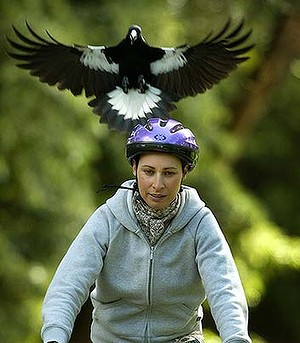Spring ‘Magpie swooping’ season in full flight
<!—[if gte mso 9]>
How to survive or prevent an attack
Yes, it’s that season again, when magpies swoop and cyclists are skittish. Just as it starts to warm up and the mornings aren’t quite as dark comes the ever-present threat of feathered ‘magpie’ fury from the sky.
Cyclists are also covering more turf and thus may experience more magpies so maybe they’re just exposing themselves during the Spring nesting season to more harassment?
More info: http://www.magpiealert.com
What measures do you employ to minimise attacks? Send us your suggestions and experiences?
Blog by Michael O’Reilly – the Age 2012
Two years ago, an article in Australian Geographic gave some fascinating information from behavioural ecologist Dr Darryl Jones.
Firstly, only 12 per cent of magpies swoop, and 99 per cent of them are male. More curiously, magpies don’t all have the same pet hates. Just over half of them attack pedestrians and leave cyclists alone, 29 per cent will have a go at walkers and cyclists, and 8 per cent of them are exclusive haters of bike riders.
Which begs the question – why are so many of them on my favourite cycling journeys? Magpies tend to nest in the same spots every year, meaning déjà vu attacks for anyone cycling a regular route.
After six swooping seasons, and much gabbing with other cyclists, I’ve compiled this non-exhaustive, entirely unscientific list of magpie coping strategies.
• Avoid hotspots. You’ll soon learn the location of swooping magpies on your regular routes. If possible, amend your journeys until the danger passes.
• Study this map. A Google asset that is becoming a useful resource for cyclists.
• Look like a relative and wear a Collingwood scarfe, it might just help?
• Cable ties. Many cyclists reckon that festooning your helmet with spiky cable ties helps to keep beaks and claws at bay. If so, looking like a pedalling porcupine is a small price to pay.
• Stick “eyes” on your helmet. The jury is still out on the effectiveness of rearwards-facing fake eyes. But kids love ‘em.
• Wave your hand in the air. Mr Magpie doesn’t want to get hurt – that’s why he comes at you from behind. Confuse him by flapping a hand behind your head if he is hovering.
• Ride fast. High speeds through sniper alleys can be effective. There again, I was once pecked by the Spit Bridge Stuka when I was doing 45kmh.
• Ride carefully. Magpie attacks have caused many cyclists to have accidents. It’s better to be pecked and stay upright than have a stack while trying to take evasive action.
• Wear a helmet. Nanny-state, near-unique helmet laws have done a lot of harm to utility cycling in Australia – but at least a lid protects parts of your scone from swoops.
• Don’t wear a helmet. Some birds have been shown to have a unique hatred of stack hats. Hard to know which ones, though!
• Quit riding until November. OK, that’s just a joke.
Seriously though, magpie mayhem is just another of the mixed joys of riding on Australian roads. It’ll be over once summer settles in, and before you know it, you’ll be saying, “not again”.
What measures do you employ to minimise attacks? Send us your suggestions and experiences?
<!—[if gte mso 9]>
News & Info Sections
-
News
(38 items)
-
Information
(30 items)
-
Tips
(18 items)
-
Offers
(2 items)
-
Ideas and suggestions
(13 items)
-
Headlines
(25 items)
-
Ride to work
(20 items)





